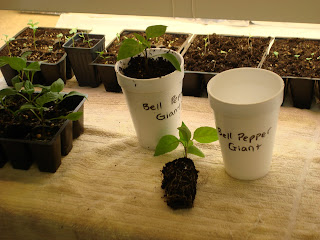While our neighboring state to the north rolls its collective eyes at winter precipitation advisories, we have steely grey skies with highs in the 40's and 50's F. Too cold for beans... even peas will just sit and wait this out; but spinach takes it like the Energizer bunny and keeps on growing. In two weeks we hope to be harvesting sweet green leaves loaded with vitamins. While we're thinking about it, time to drag out the Black Hen composted chicken manure (people with sensitive noses be advised, this stuff is really smelly) and sprinkle a helping down the rows for an extra boost of very natural nitrogen.
Our velvety green carpet of red clover has grown knee-high during the last month, but I've been plotting how to kill it: we're several weeks away from corn planting, and it's time for our green manure to work its magic, turning sterile subdivision soil into a humusy, fertile compound. Mowing it may kill the lawnmower. Weed whacker? I'll be vibrating all night. Neighbors might act jittery if I head out there with a scythe in hand... Looks like a tiller wins out as the power tool of necessity, though it will take several passes to completely lay clover to rest. Our rain gauge measured 2.1 inches collectively over the weekend, and soil is much too wet to till. Will have to wait for a drier weekend.
 Though it is too soggy for outdoor chores, bell pepper seedlings under fluorescent lights indoors have been drying out every day, a sign that they need to be transplanted. Foam cups make inexpensive pots, not organic I know, but recyclable. Anything may be used. It's the vigorous root systems this extra growing space encourages that helps transplants take off after they are moved to the garden. We've made reflectors out of cardboard sheets covered in aluminum foil to help keep light focused and strong for stocky plants. In a couple months these tiny seedlings will become major architectural landscape elements in the yard.
Though it is too soggy for outdoor chores, bell pepper seedlings under fluorescent lights indoors have been drying out every day, a sign that they need to be transplanted. Foam cups make inexpensive pots, not organic I know, but recyclable. Anything may be used. It's the vigorous root systems this extra growing space encourages that helps transplants take off after they are moved to the garden. We've made reflectors out of cardboard sheets covered in aluminum foil to help keep light focused and strong for stocky plants. In a couple months these tiny seedlings will become major architectural landscape elements in the yard.

Great post! So cute. Who's writing this blog? I assume it's Bryan but I'm not sure. Anyway, it's terrific! Think you should write a book on gardening. Best seller!
ReplyDeletehttp://mshipe4.wordpress.com/
Thanks!
ReplyDeleteBryan is the creative one - combining his passion for gardening with his love of writing. Joy is the techie - taking care of design work and posting.